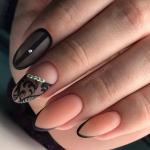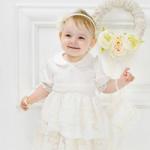Basic wardrobe for a 5 year old child. Child's summer wardrobe: step-by-step instructions
.
But I’ll copy it to the blog in case it’s useful to someone.
Why is a children's wardrobe so difficult? At least in my opinion...
Firstly, because our children are constantly growing! This means that when creating a seasonal wardrobe for a child, you need to take many factors into account. The most difficult of them is to foresee which things will have to be replaced first, taking into account growth, and what exactly to replace them with.
Secondly, children have much more requirements for their wardrobe than we do. Their activities are much more varied than ours. And in any situation, children want to feel comfortable - whether they are climbing a tree, painting a masterpiece on the wallpaper, or playing hide and seek.
So, Our task is to form a beautiful and versatile wardrobe for a child from a rational perspective - so that there is enough of everything, so that everything is combined, but so that there is NOTHING EXTRA.
My son is a little over 2 years old. He grows, and I grow with him. Of course, I mean experience and knowledge. Now it comes to clothes. I realized my mistakes and am looking for ways to solve them.
So, my main mistakes:
1. I bought a lot of different things according to the principle “oh how beautiful, oh how cute” or even better during the sales period “cool, sooooo cheap thing, it will come in handy.” This issue became especially acute after my acquaintance with shopping on foreign sites. I think many will understand me...
2. I’m bad at making advance purchases. Something is missing later, some things we don’t even have time to put on. Especially considering that the weather can sometimes be very unpredictable.
Who else has this?
Let's try to make a list of necessary things. This will be a cheat sheet. So that you don’t buy too much, but also don’t forget anything. I would like to clarify right away that the list is indicative (we make adjustments for age, gender, climate, etc.).
Underwear + thermal underwear
Of course, underwear for children, especially for babies, must be of high quality. This applies to both the material from which children's clothes are made and the quality of tailoring. The size of children's underwear should be as comfortable as possible for the child. Clothes that are too narrow or tight, as they impede the baby’s free blood circulation, are completely unacceptable. You shouldn’t buy underwear “for growth.” Such spacious things sometimes rub children's delicate skin and cause discomfort in babies. It is best to select sets that are just right for the child.
Tights and socks
Tights are an integral attribute of a child's wardrobe from 3-6 months of age until the age of 7 for boys, and for girls - for the rest of their lives.
Therefore, when choosing tights, keep in mind: the more they contain natural cotton, the more pleasant they will be to wear and the more useful they will be for the baby, but the sooner they will lose their shape and color, tear or fray to holes. So be prepared for these losses in advance. However, a small percentage of chemical fiber in children's tights will significantly alleviate this problem. Woolen claws are also produced for the cold season, but they should not be worn in a warm room or in the summer, especially for boys.
Accessories (belts, suspenders, glasses, scarves, bow tie, etc.)
Hats
Pants, jeans and shorts
T-shirts or bodysuits
Shirts, blouses
Raglan, turtlenecks
Turtlenecks are an indispensable item for walking. They can be of completely different patterns and colors. And even if the jacket unbuttons during a walk and the scarf ceases to perform its function, the neck will always be covered by the neck of the turtleneck. In stores you can find them in different fabrics. The warmest and most comfortable are turtlenecks with 20–50% wool content (unless, of course, your child has contraindications to wearing wool fabric). They can be combined with trousers or jeans, with skirts, sundresses and even dresses. Two turtlenecks in a child’s wardrobe is the required minimum.
Sweaters, sweatshirts, cardigans
Blazers and cardigans
Outerwear (overalls, jacket, coat, vest)
Jacket, coat or overalls with insulation (sintepon, polyester, fleece, goose down). Make sure that the length of the jacket reaches at least the beginning of your baby’s thigh, otherwise it will ride up all the time, causing inconvenience during a walk. It is also important that the sleeves protect your hands from dirt and wind. A hood would also be very convenient. The ideal collar will be stand-up, but with additional soft cloth from the inside so as not to damage delicate skin on the chin.
For a base, 2 different jackets are quite enough; one is not enough, if only because there must be something to replace it in case of unforeseen situations.
In order not to overheat your child with warm outerwear, it is good to have a comfortable vest or jacket that you can put on in the cold morning hours or take off in unexpectedly warmer weather. This will make it more comfortable for your baby to run and jump.
Skirts
Dresses
Swimwear
Homewear and pajamas
Don't forget about home clothes. It is better if this clothing is purchased only for this purpose and will not be worn anywhere else. We give preference to clothes made from natural fabrics, calm colors, comfortable and light - shorts and T-shirts, knitwear simple dresses etc. We think about night pajamas and nightgowns, taking into account the time of year.
Tracksuit (or uniform)
Clothing for trips to holidays and special events
The main selection criteria: festive clothes should be fundamentally different from everyday clothes, be comfortable (so that the child feels comfortable) and preferably have a classic cut. Try to choose dresses for girls with moderate decoration - unobtrusive braid or lace trim. Severely “overloaded” dresses can look funny. It is better to make accents with the help of accessories: hairpins, ribbons, bows, shoes and socks.
Shoes by season
School uniform
On the Internet, I came across several examples of filling a children's wardrobe. The images had to be greatly reduced, but I think the principle is clear.
Urban clothing, unlike items for outdoor games, is more elegant and less practical. Girls feel comfortable walking in the park, visiting master classes, shops and children's cafes in dresses, skirts with sweatshirts, slip-ons, moccasins or sneakers. For boys, cotton chinos, light jeans, shirts or T-shirts with a cardigan, leather boots, sneakers or sneakers are suitable. From outerwear- coat, sheepskin coat, windbreaker and quilted jacket. Gradually it is added to the city things sports uniform and replacement shoes, and they transform into clothes for school.
Clothes for special occasions
When choosing fluffy dresses, trouser suits, ties and lace blouses, think about how many times a year the child goes out into the world. If your family’s lifestyle does not follow the slogan “one event - one outfit,” two sets of clothes will be enough for your child.
An evening wardrobe for a little lady consists of an elegant dress, a suit of a skirt, top or bomber jacket, outerwear that matches the style of the main outfit, low-heeled shoes or slip-ons, a bag or backpack, hair jewelry and a headdress. Dressy shoes for girls are not suitable for walking and as replacement shoes, so they will not be able to perform several functions.
Children have a unique gift - when minimum costs time and effort to create maximum chaos not only in your room, but throughout the entire apartment. It makes no sense to demand that a child put things in order if adults have not taken care of creating a functional system for storing children's things. In this regard, the ideal antidote to chaos is a spacious, well-equipped children's dressing room. Do not rush to argue that in a small apartment this is an unaffordable luxury. Let's take a look into the nursery together and think about how to structure its space.
Why do you need a children's dressing room?
In the understanding of most people, a separate dressing room is, in addition to additional convenience, also additional square meters. But if you correctly redistribute the space of the apartment, from arranging a module to organizing a children's wardrobe, you will only benefit.
A spacious dressing room is an opportunity to hang and lay out everything in plain sight, which will allow easy to choose outfits, arrange wardrobe items together, quickly find what you need.
By allocating part of the room for storing children's things, you will unload the remaining space from chests of drawers, cabinets, boxes with toys, than visually expand the nursery.
The use of mobile shelves and containers will allow make the most of internal, including vertical, space.
Remember about educational function- nothing helps like that teach your child to be neat, like the order in the room that surrounds the baby from infancy. By dressing himself and putting things back in their place, he gets used to self-care.
And finally, even if, when dressing a child in the morning kindergarten, you didn’t have time to put things back in place, all this will remain behind the dressing room door;)
 |
 |
Specifics of a children's dressing room
By many parameters children's dressing room looks like an adult, but has specific features, so let's look at what you need to pay attention to when equipping it.
1. Ideal for a child modular system for organizing things, allowing you to change the configuration of the compartments as it grows, and adjust the height of the rods and shelves. Order a transforming cabinet, the design of which allows for the layout of the internal space at your discretion.
2. Most likely here Not only clothes will be stored and shoes, but also toys, books, stationery, sports equipment, so when planning it is necessary to provide a place for them.
3. Children's dressing room better to do with the door closed(and not behind curtains or in a niche), especially if you are not ready to clean up the open shelves every day, and your child is not yet a model of neatness and pedantry.
4. Pay attention security. There should be no heavy drawers, poorly secured modules, shelves with sharp corners, or other objects that could injure a child.
5. There is such a psychological technique: in order to understand a child, you need to squat down and be on the same level with him. Similar a children's dressing room must be planned based on the height of its owner– everything necessary should be within the baby’s reach, especially casual wear, shoes and toys.
6. In order not to clutter the shelves, children's things must be go through at least twice a year– get rid of small clothes and toys that have become unusable. This is best done in the spring and fall to simultaneously prepare and store seasonal items.
 |
 |
Ideas for equipping a children's dressing room
In a duplex penthouse or country house You can set aside a separate room for a children's dressing room, but most city apartments do not have such potential. How to be in this case?
If there is a storage room adjacent to the children's room with a width of 1.5 m and a depth of at least 1 m, it is quite possible to adapt it for the above purposes.
The second option is a niche in the room. You can place a custom-made wardrobe in it or fill the recess with your own made shelves and storage devices.
If there are no such architectural elements in the apartment, a part of the room is allocated for a dressing room, having previously separated the desired segment using a plasterboard partition.
You can do without a stationary partition, and zoning the room using a screen decorated in uniform style with the interior of the room.
Paradoxical as it may seem, but separate dressing room not only does it not take away, but on the contrary, saves space- through rational use of available space.
 |
Tips for zoning interior space
Whatever option you choose, there are general requirements for the internal layout of the module. All the space you need divide into several zones:
For placing outerwear;
For short clothes that are stored on hangers;
Shelves for storing folded items;
Shoe area;
Segment for storing toys;
Changing area with mirror and bench (ottoman).
 |
 |
What and how to store: accessories and containers
A children's wardrobe often exceeds an adult's in the number of items, and therefore requires similar approaches to storage.
Outerwear, casual suits , dresses, skirts, trousers rationally hang on hangers and place in the lower sections of the dressing room, output kits- higher up, in the second tier. For these purposes you will need special ones, preferably wooden ones. The set must include regular hangers with recesses and a crossbar - for trousers and skirts, - for shirts, blouses, suits made from natural fabrics. The flocked surface prevents clothing from slipping and the formation of puffs.
Knitted blouses, tracksuits, t-shirts, sweatshirts stored on open shelves. An interesting solution is open fabric hanging trunks with several sections. A convenient fastening system with ties or Velcro makes them mobile, the dense material holds its shape well and is easy to clean.
For the same knitwear, bed linen, blankets, pillows, blankets, you will need spacious boxes or shelving baskets. These can be transparent containers, stylish boxes, decorated with children's applique.
T-shirts, shorts, underwear, socks, tights stored in drawers designed like a chest of drawers or on open shelves in. A compact system consisting of separate cells makes it easy to navigate the contents, maintain order, and not lose paired items.
Shoes stored on open shelves, in several compartments. Hanging trunks with pockets are also suitable for these purposes. To save space, you can hang them on the back of the door and use them not only for sandals and slippers, but also for various small things - bows, elastic bands, scarves, hats.
Seasonal clothes, kits for growth put in boxes and put on the upper shelves, mezzanines.
Toy zone placed on the floor, lower shelves so that the child can easily reach and put them away. To do this, the dressing room is equipped with retractable mesh trays, spacious containers on wheels,. Children love to put their treasures in colorful boxes with playful designs.
 |
 |
In conclusion, we offer some tips for decorating a children's dressing room that will make this room comfortable and aesthetically attractive.
1. Light colors of walls and surfaces, a mirror will visually expand the space of a small room.
2. Provide lighting from several sources - the child should not choose clothes and dress in the twilight.
3. A joyful children's atmosphere is created by objects with a playful design, for example, with images of cartoon characters, decorative tags and stickers that allow you to remember what is where, multi-colored hangers, etc.
Habit is second nature. From childhood, raise your child to be neat, teach him order, teach him independence, “sow” positive habits and “reap” a solid character.
For most babies and their mothers, summer is a long-awaited time. After all, all people without exception associate this time of year with exciting adventures, long-distance travel, meetings with friends and relatives in an informal setting, as well as new acquaintances and unexpected discoveries.
Summer weather requires the presence of an appropriate wardrobe that will allow the baby's body to be in conditions of thermal comfort, breathe and be protected from direct exposure to the ultraviolet spectrum of the sun's rays.
Despite the fact that children’s summer clothes are most often used only for one season, their choice should be approached responsibly, giving preference to practical and at the same time high-quality models.
Before you start replenishing your children's wardrobe for the summer, you need to mentally identify three main groups of things: for hot and cool weather, as well as for rainy days. Ideally, each group should be represented by at least four sets for daily wear and one “going out” outfit.
In the summer heat, you can’t do without T-shirts, which should be bright and with life-affirming prints. It is desirable that they go well with basic things wardrobe, looked good on the baby and had natural composition. The inclusion of no more than twenty percent artificial fiber is acceptable. Natural cotton fabrics have faithfully served humanity for many years, providing optimal conditions for heat exchange and protecting against unwanted exposure to ultraviolet rays.
As for the main color of T-shirts, despite the soiling, preference should still be given to products made from white fabric, as this indicates the absence of dyes and also guarantees that most of the sun's rays will be reflected from its surface. Psychologists insist on excluding aggressive and toxic colors from a child’s wardrobe, since this can negatively affect the mental state of a child who is constantly under the influence of such color combinations.
For babies in the first years of life, bright bodysuits with short and long sleeves are much preferable to T-shirts. They will provide them with the necessary comfort during a walk, relieve their mother from unnecessary worries and guarantee impeccable appearance under any circumstances.
In addition to T-shirts, the clothing group for hot days should include several shirts with short sleeve for boys and several blouses with puff sleeves for girls. Shirts from natural fiber will provide no less comfortable conditions for the baby’s heat exchange than T-shirts, but at the same time, they will introduce an element of style into his wardrobe and become a kind of indicator of adulthood. Among other things, the shirt will be a powerful incentive for development fine motor skills, because everyone will want to learn how to fasten buttons on their own, like dad or mom does. Light blouses for girls can be safely combined with a sundress, shorts, trousers and a skirt, creating new outfits and gradually introducing the baby to the basics of fashion and practicality.
In hot weather, both girls and boys simply cannot do without shorts, which today are made in various lengths and allow each child to choose exactly the option that suits them best. The material for them should also be natural or predominantly natural, and the colors should be chosen to be universal, which will allow you to achieve ideal combinations with all the additional elements of your wardrobe. Ideally, it is advisable to purchase short and long shorts, as well as breeches for both boys and girls, to whose wardrobe it would be a good idea to add tight-fitting cropped leggings.
Babies who go out for walks in diapers will not do without overalls, and for older babies you should purchase several pairs of light trousers from cotton fabric. The group of clothing items for hot days is completed by a cap or panama hat, which should be replaced by a bandana for boys and a bright scarf with a visor for girls.
Cooler days require appropriate changes in clothing. In such weather conditions, the baby can wear thick long trousers, a golf shirt, a sweatshirt or a light sweater, and for extremely cold weather a denim jacket or windbreaker should be provided. In such clothes you can safely go into nature, take trips on a yacht and begin your first ascents of the mountain.
For rainy days, you should have a waterproof raincoat or jacket with a special water-repellent impregnation, a bright umbrella, thick trousers, and rubber boots who are now fashion accessory and giving kids the opportunity to enjoy walking through puddles even in the presence of their mothers.
Don’t forget about elegant sets, which, naturally, are not practical and require special treatment, but increase the confidence of the little ones in their irresistibility, and also cause undisguised delight and tenderness among others.
You can either write your own.
But it’s more about school, but I was thinking about Vikushka.
Vikushka is almost 4 years old, and in some places I probably approach her wardrobe with hyper-responsibility, but it seems very important to me, because a person grows, absorbs information about how it should be, about color harmony, about proportions, etc. and on myself too. I wasn't very good at it. WITH artistic taste maybe it’s more or less nothing like that, and it was praised in the art, but for some reason I basically didn’t think of applying all this in practice - to clothes, and not to still lifes. Yes, in the 90s in my city there was absolutely nothing to use. Chinese things from the market initially did not fit into the idea of harmony. It was only in the 11th grade that I made a discovery for myself (logically, of course, I understood this, but then I suddenly realized) that those things that are photographed in magazines - they, it turns out, exist in reality, you can try them on and buy them myself - I saw the window display of the Mango store in Moscow. Until then, pictures from magazines seemed to me like some kind of abstract beauty, from a parallel world. So, to be honest, I always dressed like shit, even though I tried to put it together as best I could. But what can you think about it if you have only one pair of boots and one jacket, and all this is not what you would like, but what was in decent quality. In the last couple of years, I think I dress normally. It’s still like we’re crawling to “stylish” in Africa.
Therefore, it seems to me that all this should be instilled in little people at once - so that later they do not have to hastily catch up, learning basic things at a fairly advanced age, as I am doing now. Of course, not to the point of insanity, because things are just things, even if they aestheticize environment, but a person should still have the right to make his own choice (even if it is wrong), he should try some combinations himself (even if they are crappy - but how else can you understand that they are crappy?), experiment on your own (otherwise where would creative solutions come from?) etc.
But in order to save myself and my child’s nerves, and so that I don’t have to get into arguments about whether it can be worn or not, I try to decide all this at the purchasing stage.
There are very good posts on how to create a rational wardrobe. The author is a fashion designer and image specialist, so everything is explained very clearly, simply and clearly: post about a rational wardrobe for a boy, post about rational wardrobe for girls. And of course, in a broad sense, this is not only about children's wardrobe, there are principles that can very easily be applied to your own.
I tried this scheme on Vikushkovy things, it turned out to be very convenient.
I started very small, with three main colors: white + cool pale pink + fuchsia(it’s clear that these are the most common colors in children’s stores, so the choice was dictated mostly by laziness, but they still look good on little bunnies): 

In addition to the ideas for a rational wardrobe, I formulated for myself personally a few clarifying rules.
Firstly, baby a lot of places climbs, draws, grabs something, can easily spill juice or stain clothes with hands in berry juice, etc. etc., and besides, it grows quickly, so clothes are mainly bought completely budget friendly- sometimes it happens that there is enough stuff for one exit, and then a stain appears, but it would be somehow strange to forbid a child to climb and explore. That's why I buy everything as inexpensive as possible, but at the same time, of course, cute. From what is suitable for Vikushka, these are mainly Sela, Lindex, HM, even Modis (they have much better clothes for children than adults), I really like LC Waikiki, which recently opened here. Recently, I even stocked up on ketai stuff from the market - such an opportunity came up - but, of course, I chose very harshly.
And from the first it turns out naturally second- through experience, I came to the conclusion that One capsule is most convenient(the original post suggests two, but I think it’s too complicated, for me anyway, I’ll explain why below), in one color and style, otherwise it is very difficult to select sets when things constantly break down and you have to look for and buy new ones, during the day every now and then you have to replace something (fell here, spilled here, tore there), sets are preferably multi-layered (remove something , wear something, sleep in the kindergarten) well, if at the same time you still have to think about color matching, then this is a brain explosion.
As a result - under an ideal set of circumstances - it turns out that you can take almost any thing from the closet and combine it with almost any other thing, and not worry about whether it fits or not - everything should fit at the selection stage. Still, when buying, you have to choose, so why not add color/style to the given criteria?
Here's how it works for me:
Well, it seems to me that this all works on Vikushka. It’s funny how she herself makes some conclusions, that, for example, “I have a purple jacket, which means I need a purple hat” (and even though I didn’t tell her this and, of course, I myself don’t think that purple only purple is suitable, but it’s still great that the child compares such things himself and draws his own conclusions in his head, that she has some of her own ideas about elementary color harmony).
And recently, I was really proud of how Vikushok herself chose the prints on the dress and skirt - she wanted to dance, and for this, she thinks, she needs a skirt. And so she put her skirt under her dress and came running to me. “I think they fit well - look, here are flowers and here are flowers, here is gray and here is gray,” said the little man. I praised. Let's leave the possibility of combining this dress with this skirt out of the question; the point is not that, but the fact that the small man himself performed a series of logical operations and made some kind of conscious and informed decision. And even if she tries a lot of things, messes up a lot, does a lot completely wrong (in the end she dyes her hair red and her lips black), but a person learns to compare colors, textures and shapes, looks for how to do it beautifully, how to express yourself, after all.
I still don’t know how to make super looks, like the ones from catalogues. Probably, someday I will learn, but this is not the most important thing - I don’t need the person to be a super-duper doll, but simply for everything in the person to be beautiful - both soul and costume)
Now share your thoughts) I’m talking not only to mothers, but to everyone in general - some have nephews, while others just walk down the street and see everything)






